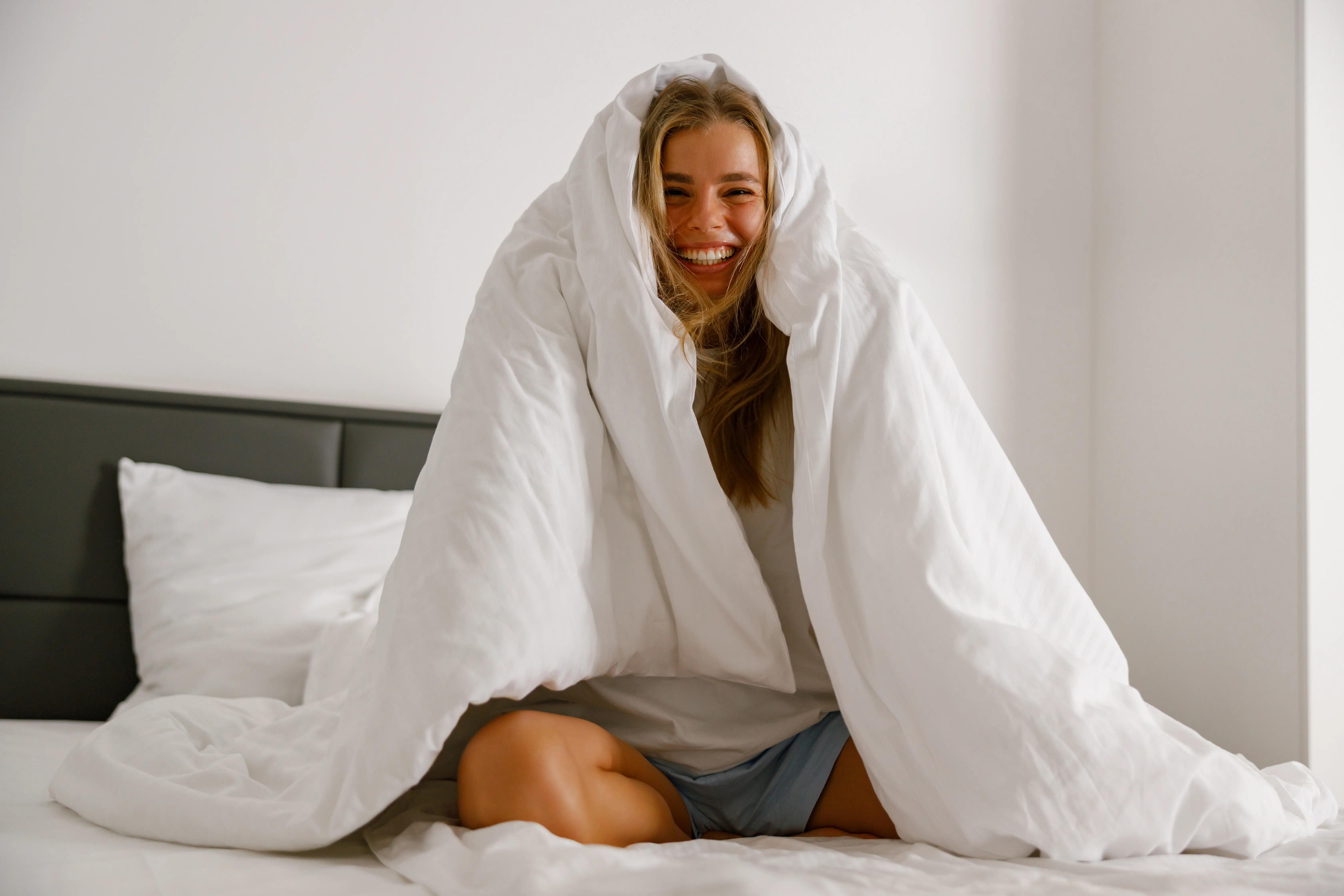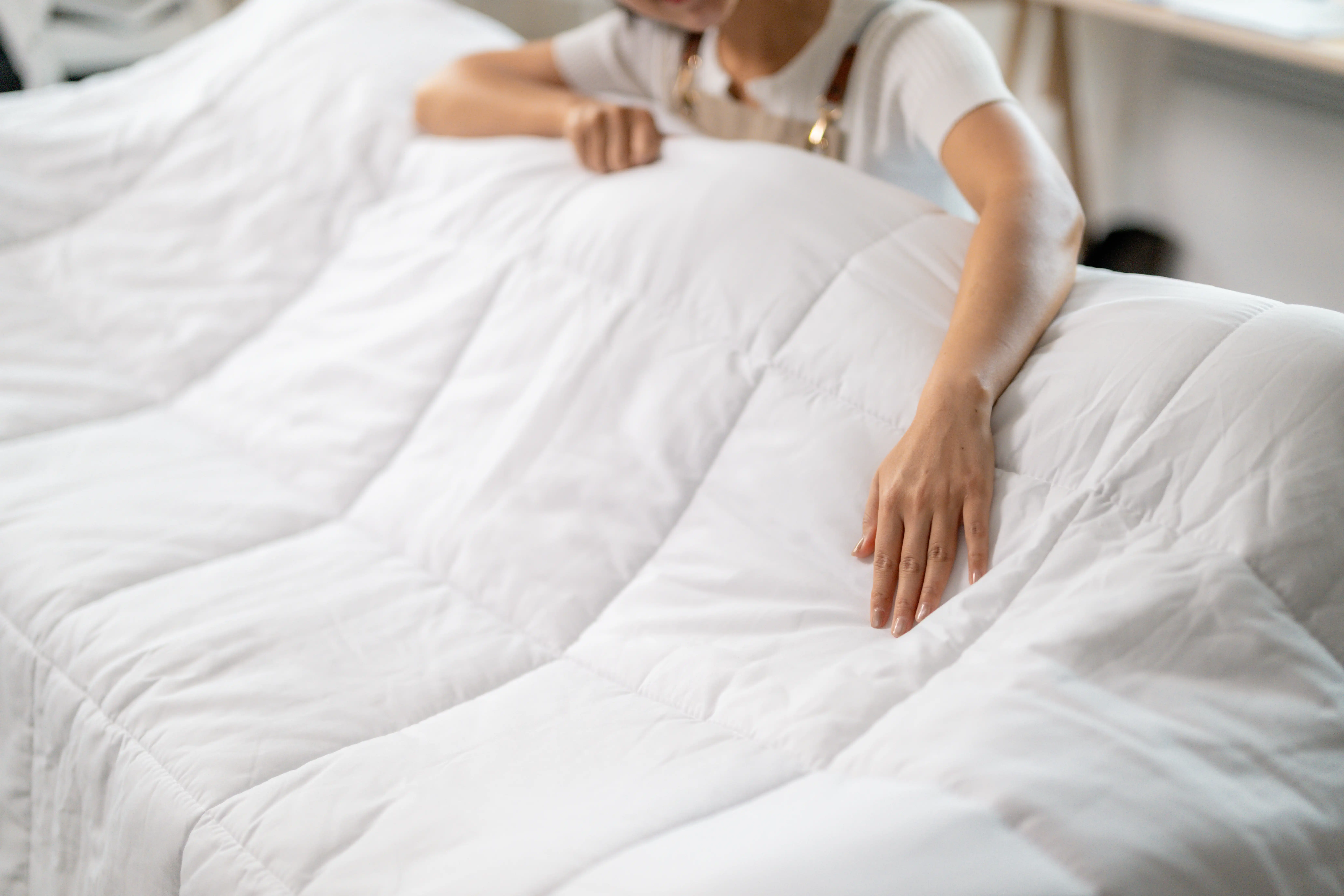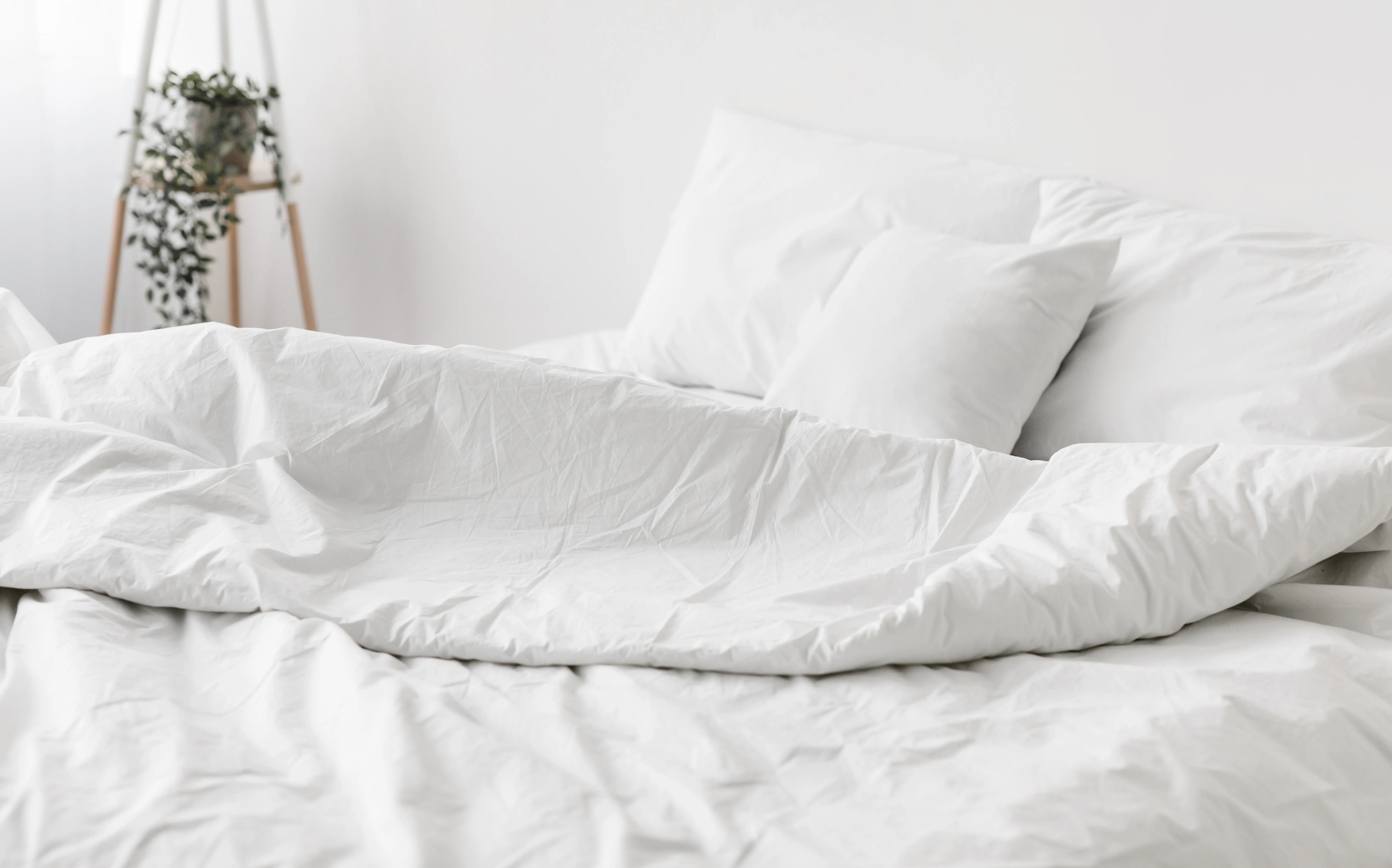
Choosing the right duvet plays a larger role in the quality of sleep than most realize. The right one will keep you warm but not overheated, will feel just right in terms of weight and texture, and will suit your lifestyle, whether you require something hypoallergenic, easy to care for, or environmentally friendly.
This article discusses what you need to know before buying a duvet: natural vs. synthetic fill, how fill power and weight work, what tog ratings are, and how shell fabric and construction types affect comfort. You'll also receive guidance on sizing, care, and how to take factors such as allergies, climate, and sustainability into account when deciding.
What is a Duvet?
A duvet is a soft, quilted blanket filled with natural or synthetic materials. Unlike a comforter, a duvet usually has a removable cover, similar to how a pillow goes into a pillowcase. This makes it easier to clean and also enables you to alter your bedding style without needing to replace the entire blanket, especially helpful if you're using a duvet cover with a tendency to bunch.
The inside of the duvet, or the duvet filling, can be down, feathers, wool, silk, cotton, or synthetic, like microfiber or hollow fiber. Each has insulation, weight, and breathability properties. Cotton, bamboo, or other soft, breathable fabrics typically make up the cover, which influences the duvet's feel and functionality.
Importance of Choosing the Right Duvet
Selecting the wrong duvet can disrupt your sleep, as it's not a universal fit. The right duvet keeps your body temperature balanced through the night, which is especially important in regions with seasonal changes.
Duvet material choice also matters if you have allergies or sensitive skin. Some duvets use untreated down or coarse shell material that can cause skin irritation. Others use hypoallergenic filling and densely woven shells to reduce exposure to allergens.
Durability is another key factor. Some duvets are made to last a decade or more, while others start to lose warmth or shape after being washed a couple of times. Being knowledgeable initially prevents you from having to do unnecessary replacements and enhances sleep comfort over time.
Key Factors to Consider When Choosing a Duvet

In this section, we will discover the most significant factors that enable you to make an informed decision that meets your personal sleeping needs.
Fill Material
The duvet filling is the core of the duvet and has the biggest impact on warmth, breathability, and maintenance. Different duvet types offer unique benefits depending on the fill used. It also plays a role in whether the duvet is suitable for people with allergies or temperature sensitivities. Fill types can be categorized into two main groups: natural and synthetic. Each one comes with its own feel, warmth level, and maintenance needs.
Natural Fillings:
- Down Fill: It's a natural filling made up of soft under-feathers of geese or ducks. It's very lightweight and highly efficient at trapping heat, making it best suited for cold climates. High-quality down duvets with high fill power can last years of use with proper care and give long-term comfort and insulation.
- Feather Fill: This is a natural filling sourced from the outer feathers of birds. It's denser and less airy than down, offering more weight and a heavier feel to the duvet. While it doesn't insulate so much as pure down, it offers good value and a satisfying heft.
- Feather and Down-Fill: This is a natural blend that combines the loft and softness of down with the weight and affordability of feathers. It's a compromise if you want warmth and comfort without fully breaking into the premium-price range.
- Wool Fill: This is a natural filling with temperature-regulating characteristics. Wool will keep you warm in winter and cool in summer as it pulls moisture away from the body, making it a great natural alternative to more structured bedding options like a weighted blanket. It is also naturally resistant to dust mites and mold, making it a suitable option for sleepers with allergies.
- Silk Fill: This is a natural filling that is breathable, light, and hypoallergenic. It's great for people with sensitive skin or those who tend to overheat at night. Silk duvets provide a soft, silky texture and drape well, providing a cool, luxurious sleeping surface.
- Cotton Fill: This is a natural filling, though less common than cotton fabric covers. It is soft, light, and cozy but fails to insulate as well as wool or down. Cotton-filled duvets work well for summer sleeping or in hot conditions.
- Linen Fill: Linen is a natural filling that's even more breathable than cotton. It's light, airy, and long-lasting, making it perfect for hot sleepers. Although not yet popular, some luxury or eco-friendly brands use it.
- Bamboo Fill: This is a natural, eco-friendly filling that is antibacterial by nature, breathable, and moisture-wicking. Bamboo-filled duvets are light and suitable for warm weather or year-round comfort in temperate climates.
Synthetic Fillings:
- Down Alternative: This is a synthetic filling made of polyester fibers designed to mimic the loft and softness of down. It's a suitable choice for allergy sufferers or those who do not use animal products. It's also typically less costly and easier to clean than natural down.
- Fossflakes Fill: This is a synthetic filling made up of very small, fluffy flakes that are meant to mimic the feel of down. It's durable, hypoallergenic, and well-known for retaining shape and loft over time.
- Microfiber Fill: This is a synthetic filling made up of ultra-fine fibers. It's light, airy, and warm, an excellent option for sleepers who prefer plush comfort without the expense of down.
- Hollow Fiber Fill: This is a synthetic, hollow-core filling that traps air to keep it warmer. It is slightly heavier than microfiber but provides good ventilation and warmth at a fair price.
Fill Performance
Even with the right material, your duvet’s actual feel depends a lot on how the fill is measured and used. That’s where fill power and fill weight come in; both help determine how warm, light, or bulky the duvet will feel.
- Fill Power: This tells you the fluffiness or loft of the down. The higher the fill power, 400 to 900, the more air the down traps and the better the insulation. The higher the number, the warmer with less weight.
- Fill Weight: Fill weight is the weight of the fill used, usually measured in grams. More weight usually means more warmth, but it also depends on the type of fill. High fill power down, for example, may be lightweight but offer excellent insulation, while synthetic fills may require more weight to offer the same level of warmth.
Warmth Level
Duvets are not all the same in warmth, and it is where the tog rating comes into play. Tog is a measuring system (mainly used in Europe and the UK) to indicate how insulating a duvet is.
The greater the tog, the warmer the duvet, and knowing the warmth level is especially useful if you're layering with other types of blankets, such as throws or weighted bedding.
- All-Season Duvets: They come in two pairs: a lighter (like 4.5 tog) and a warmer (9 tog) one, which can be used separately or clipped together based on the season. All-season duvets are an excellent option if your climate experiences significant fluctuations.
- Winter or Extra-Warm Duvets: Ideal for cold sleepers or cold bedrooms. Generally 12–13.5 tog or more, and often filled with down or wool for great insulation. These will typically feel warmer and cozier.
- Lightweight or Summer Duvets: Ideal for hot weather or hot sleepers. These are typically 4.5 tog or lower, with breathable fill such as cotton, bamboo, or silk. They are airy and prevent overheating.
Outer Fabric Quality
Although it is the filling itself that delivers warmth, the outer fabric (or duvet shell) contributes significantly to how the duvet feels against your skin, how breathable it is, and how long-lasting it is.
- Cotton: The most common shell material. It's soft, breathable, and resistant. Use long-staple cotton or percale weave if you like a crisper feel, or sateen if you like something more luxurious and smooth.
- Silk: Smooth and cool naturally, silk feels luxurious and is also hypoallergenic. But it's delicate and usually needs more care, often dry cleaning only.
- Bamboo: Bamboo fabric is naturally soft, breathable, and antibacterial. It's also a sustainable option that's great for hot sleepers or those with sensitive skin.
- Microfiber: Microfiber is a synthetic fabric that's light and soft. It's usually cheaper than natural fibers but isn't always as breathable and can hold heat in warmer climates.
Tip: Shell quality also depends on thread count. A higher thread count (e.g., 300+) equates to a tighter weave, which should help keep the fill in place and reduce allergens.
Construction Types
The duvet's warmth and evenness depend on how well the duvet filling stays even, which is affected by how it's sewn.
- Baffle Box: This design uses internal fabric walls between the top and bottom layers to let the fill loft fully. It minimizes cold spots and provides consistent warmth. Typically employed in high-end or winter-season duvets.
- Box Stitch (Sewn-Through): Here, the stitching goes straight through from top to bottom, creating quilted pockets. This stitching technique is typically found in lighter or lower-priced duvets, but it can sometimes result in uneven filling.
Duvet Size and Fit
Choosing the right duvet sizes isn’t only about mattress dimensions; it also depends on how your duvet will sit alongside other blanket sizes or bedding layers.
| Size | Approx. Dimensions (inches) | Best For |
|---|---|---|
| Twin | 64 x 86 to 68 x 88 | Twin beds, kids, single sleepers |
| Twin XL | 68 x 90 | Extra-long twin beds (common in dorms) |
| Full (Double) | 86 x 86 to 86 x 86 | Full beds, solo adults who prefer more space |
| Queen | 86 x 86 to 90 x 94 | Queen beds, most couples |
| King | 104 x 90 to 110 x 98 | King beds, couples who want extra room |
| California King | 104 x 100 to 110 x 100 | Cal King beds (longer but narrower than King) |
Note: Dimensions vary slightly between brands, so always double-check the size guide before buying.
Additional Considerations
Beyond the basic details like fill and material, several other factors can influence how a duvet will fit into your life. If you're sensitive to allergens, need something easy to clean, or want to buy more responsibly, these points can assist you in narrowing your options and maximizing satisfaction.
Allergies and Sensitivities
Some duvet materials are more likely to trap allergens like dust mites, pet dander, or mold, especially if they trap heat or moisture. If you're allergic or sensitive, the best option usually comes down to materials that resist buildup and are easy to clean.
- Hypoallergenic Fill Options: This is a synthetic solution. Materials like microfiber, hollow fiber, and Fossflakes are commonly labeled as hypoallergenic. These fills have a better repellent quality against allergens compared to untreated natural materials and are usually machine washable, thereby making them more convenient to handle.
- Natural Alternatives: These are natural products that still work well for allergy conditions. Wool, silk, and bamboo are breathable and moisture-wicking in their nature, which keeps dust mites and bacteria away without the use of chemical treatment.
- Barrier Weaves: This is a fabric-based solution. Tightly woven cotton shells, typically with a thread count of 300 or higher, create a strong barrier to allergens. Having a removable, washable cover on your duvet adds another layer of protection.
Washability
Cleaning ease plays a big role in day-to-day convenience. Synthetic duvets are usually the most practical; many are fully machine washable and dry quickly, making them ideal for regular use, guest rooms, or households with pets and kids.
Natural duvets need more attention. Down- or wool-filled duvets can be washed on delicate cycles, but others should be dry-cleaned or professionally washed. Even duvets with washable labels require drying to prevent clumping or mildew. Always follow the manufacturer's instructions and know that some duvets will need a large-capacity washer or special detergent to wash properly.
Sustainability
If you prefer products with a lower ecological impact, there are many duvets today produced using sustainable materials and green sourcing methods. Look for fills made of recycled polyester, organic cotton, bamboo, or wool. These resources are renewable, biodegradable, or made from recycled consumer waste.
Certifications allow us to make sure that these are sustainable options. The Global Organic Textile Standard (GOTS) covers ethical manufacturing and organic content. OEKO-TEX ensures fabrics have been certified to be safe from toxic chemicals. The Responsible Down Standard (RDS) confirms that down comes from well-treated animals.
Sustainable duvets reduce environmental impact and are more transparent, so you can be sure what you are sleeping on.
Maintenance and Care Tips

A duvet will last many years with proper duvet care, cleaning, and storage. As different materials need different care, following proper procedures will be best to preserve both filling and outer fabric, and also maintain comfort and performance over time.
- Check Care Label: Always begin by reading the care label attached to your duvet. It will indicate whether the duvet is machine washable, what water temperature to use, and whether professional cleaning is recommended.
- Wash Synthetic Duvets Gently: This is a synthetic care method. Most synthetic duvets can be washed at home on a gentle cycle using a mild detergent. Use cool or warm water, and avoid using strong chemicals or fabric softeners. Too much washing will degrade the fill, so only wash synthetic duvets when necessary.
- Handle Natural Duvets Carefully: This is a natural care method. Natural fills like down, feather, and wool need more gentle handling, especially if you're aiming to maintain that fluffy look over time. Some can be machine washed, but most need to be professionally cleaned to maintain their loft and prevent damage. If washing at home, use a large-capacity washer and follow any special care guidelines from the manufacturer.
- Dry Thoroughly: Whether natural or synthetic filling, always make sure the duvet is thoroughly dry before use or storage. Tumble drying at a low temperature setting is most effective. Adding clean tennis balls or dryer balls to the cycle can disentangle clumps and restore fluffiness, especially for down-filled duvets.
- Using a Duvet Cover: A duvet cover protects against spills, stains, and general wear and tear. It reduces the need to wash the duvet itself and simplifies everyday cleaning. Use of a cover also extends the life of the filling and cover material.
- Storage Recommendations: Store the duvet in a dry, cool location when not in use. Choose a breathable cotton storage bag over plastic, as it can capture moisture and promote mildew. Always ensure that the duvet is completely dry before storing it in order to avoid mold or odors.
FAQs
How do I know what duvet to buy?
Select a duvet based on the fill type (such as down, wool, or synthetic), warmth level (tog rating), allergy needs, and whether you sleep warm or cool. Choosing the wrong duvet can reduce sleep quality and may lead to tossing, restlessness, or frequent yawning during the night.
Should I buy a duvet bigger than the bed?
Yes. A larger duvet improves comfort, prevents drafts, and provides better coverage, especially for couples. It also enhances the appearance of the bed and minimizes sleep disruptions that might lead to tossing or restlessness.
What material should your duvet be?
Down provides warmth and lightness. Wool and silk are breathable and hypoallergenic. Cotton and bamboo are excellent choices for hot sleepers. Synthetic fills work well for allergy sufferers and are easy to clean. The right material supports better sleep and reduces overheating.
What is fill power in a duvet?
Fill power indicates how much down loft a duvet can provide. Higher fill power (600–900) means greater warmth with less weight, which helps maintain comfort without heaviness. Lower fill power may lead to poor insulation, causing restless sleep or frequent yawning during the night.
What is the best quality duvet?
The best duvets feature high fill power (700+), premium materials such as wool or goose down, durable stitching like baffle box construction, and trusted certifications like OEKO-TEX or RDS. High-quality duvets provide consistent comfort and support for deeper, more restful sleep.
Conclusion
The right duvet can make a huge difference to sleep by delivering the right combination of warmth, weight, and comfort. Understanding the different fill types, how fill power and weight influence performance, and considering factors like allergies, climate, and sustainability allows you to make a choice that perfectly matches your personal needs.
Whether you prefer the softness of down, the breathability of wool, or the ease of synthetic fills, a considerate choice will offer years of restful, uninterrupted, and rejuvenating sleep.
Dom Abraham
As the lead content writer at Sleepiverse. Dom pours his heart into writing mattress reviews, bedding product reviews, and medically-reviewed health articles. Dom is from Portugal and likes to spend his free time writing on the beach as it gives him a sense of comfort. Aside from writing mattress reviews in front of the soothing beach view, Dom likes to experiment with new amazing food ideas.


